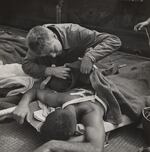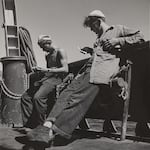As the COVID-19 crisis worsened, the federal government sent U.S. Navy hospital ships to Los Angeles and New York to help. Seventy-seven years earlier, in the midst of World War II, Portland photographer Victor Jorgensen documented life aboard the Navy hospital ship USS Solace in a series of striking images that resonate today — even if you can't visit a museum to see them right now.
Jorgensen, who died in 1994, was part of an elite team of six Navy photographers charged with chronicling life on board the USS Solace, and on three other battleships that sailed the South Pacific from 1942 to 1946.

Victor Jorgensen (American, 1914-1994), Untitled (Corpsman checks wounds) from 1945.
Gift of Victoria Jorgensen Carman and Lee Jorgensen / Portland Art Museum
Though his assignment was to simply document, he created something much larger. “He connected very deeply with the people he was photographing,” said Julia Dolan, photography curator at the Portland Art Museum, “and connected with their experiences in ways that really translate … to us today.”
Jorgensen is also known for shooting one of the iconic "Times Square kiss" photos that became a symbol for the end of the war. Alfred Eisenstaedt shot the more famed version, seen in LIFE magazine. Jorgensen's image, shot from a different angle, made the pages of The New York Times.
Related: When Portland Went On Lockdown: How Oregon Reacted To The Pandemic Of 1918
In 1990 Jorgensen’s daughter Vicky Carman was helping her parents move to a smaller house when she and her sister came across a crate of photographs in the basement. “And I remember thinking, ‘Oh my gosh, I had no idea. I had no idea that there were that many photographs.’”
Carmen had grown up not knowing much about her father’s history as a photographer. But once she started looking through the images, she was taken aback.
“It was extremely emotional. The innate artistic component of the photos was stunning to me,” she said. “Even if it hadn't been my father, just to look at photos done by someone with that amount of talent is an amazing thing. … Just that very fleeting moment of, you know, a certain emotion going through someone's face.”
Jorgensen grew up in Portland. He attended Reed College, then in 1934 took a job at The Oregonian, working first as a copy boy, then as an editor and photographer.
In 1942 he was recruited to the exclusive Navy photography team by Edward Steichen, who would later become the first curator of photography for New York’s Museum of Modern Art. Steichen told his Navy photographers, “take a few pictures of some battleships and some admirals to keep everybody happy, but focus on the man, focus on the person,” said Jorgensen’s son-in-law, Tim Carman. “The battleships are going to become obsolete. The history is going to be in the books, but the people are what we really want to record.”

Victor Jorgensen (American, 1914-1994), Untitled (off-duty crew reading mail from home) from 1945.
Gift of Victoria Jorgensen Carman and Lee Jorgensen / Portland Art Museum
Jorgensen clearly followed Steichen’s lead. There is an intimacy to his wartime photos that stands out against the harsh backdrop of these hulking Naval vessels. Traveling for weeks at a time in close quarters, he developed a bond with these sailors that allowed him to capture very personal moments. The sailors “were in a situation where they had no other option but to trust one another in order to survive,” said Dolan. “And I think that Victor deeply felt and understood that and is able to portray that trust and reliance on the group in his images.”
The photos show “their humanness, their physical nature that is so youthful and strong,” Dolan said, but “you cannot disconnect that from the threats that these very human bodies were facing as well. And the injury and destruction that was around every single corner.”
Beyond the subjects of the photos, Dolan sees great artistry. “I am consistently amazed at Jorgensen's modernist approach to photography. There are many compositions within the photographs he made that are visually stunning. He's very sensitive to the angles of weapons, of guns, of airplane wings, of individuals in relation to these machines.”
There is an eerie resonance to Jorgensen’s images today, as the world faces the dangers of a deadly virus — in some ways similar to the dangers the world faced in a world war nearly eight decades ago.
Related: Oregon Art Galleries Struggle Amid The Coronavirus Pandemic
"For many of us, this is the first time we have gone through a worldwide situation that changes the way we live our lives," Dolan said. Jorgensen's photos, seen through the lens of time, helps us feel "a sense of community, a sense of togetherness and the realization that we will get through this."
Dolan's exhibition of Jorgensen's work, "Though There Be Fury on the Waves," opened on March 13 at the Portland Art Museum. "I wanted to do this exhibition to commemorate the 75th anniversary of the ending of World War II. And I also wanted to bring Victor Jorgensen's photographs to a wider audience."
But the show was open to the public for just four hours. The next day, the museum announced that it would shut to help prevent the spread of the coronavirus. Dolan estimates that fewer than 50 people had the chance to see the show. Dolan's team has now created an online virtual walkthrough of the exhibition.
